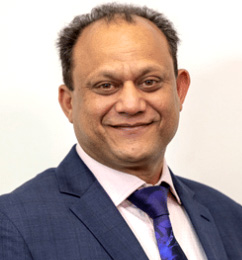Graphite and Graphene for the Green Transition: Tirupati Graphite Leading the Way

CEO: Shishir Poddar
As the world moves deeper into the energy transition, new materials are needed to support technologies that will lower carbon outputs for the future.
Graphite is officially listed as a critical mineral in the EU and the US. Its potential is vast: it has 150 applications, improves energy efficiency, and reduces carbon emissions in sectors from concrete manufacturing to fire safety.
Demand for the mineral has been further spurred by the transition to electric vehicles and is expected to grow threefold by 2030. Tirupati Graphite is a fully integrated specialist graphite and graphene producer with operations in Madagascar and India.
The firm works across the supply chain to mine and efficiently process graphite with bespoke carbon- and cost-saving equipment, and develops new technologies that promote lower emissions.
CEO Shishir Poddar is enthusiastic about the company’s growth parallel to the increase in demand. “Our growth projects across the primary graphite division remain on-track to achieve total flake production capacity of 84,000 tonnes annually by the end of 2024,” he says, “in line with our vision to be a world leader in the graphite space.”
Tirupati’s global goals reflect the broader trend of diversifying the geography of graphite suppliers. Governments are co-operating to ensure a secure supply chain for critical transition materials, and Poddar notes that Tirupati Graphite “provide an essential alternative to Chinese sources”.
High-Value Initiatives
The company embraces its responsibility to make a sustainable impact in the communities in which it operates. “We contribute towards a greener globe,” Poddar says, “and welcome this as an opportunity for value creation.”
As the mining sector is held to higher standards for monitoring community impact, Tirupati Graphite aims to add value with well-considered environmental and community initiatives, as outlined in its first sustainability report.
To develop high-value and maintainable initiatives, Tirupati consulted with communities and government bodies surrounding its projects, gaining an in-depth understanding of their needs. It has provided essential infrastructure, including drinking water facilities in four villages and 65km of road connecting projects, villages and schools. It prioritises reductions in waste and energy consumption, repurposing sand from production for house construction, and donating solar streetlights to the community.
Innovating for Sustainability
Tirupati Graphite attains industry-high recoveries of over 85 percent of graphite from ore with innovative technologies. It extracts materials as by-products to streamline processes and deliver zero-waste.
The commitment to efficiency is powered by the Tirupati Graphene & Mintech Research Centre, which leverages in-house graphite expertise to create more effective processing technologies and equipment.
Tirupati Graphite recently announced the development of a column flotation device that reduces power consumption during the flotation stage of graphite processing by around 40 percent. Installing this technology in Tirupati’s Vatomina plant and upcoming processing capacities in Madagascar will eliminate corrosion and wear in flotation and reduce the number of stages required to achieve desired graphite purity levels. The overall costs of maintenance and production are lowered, along with energy consumption.
Poddar sees this as crucial to Tirupati’s mission for both planet and business. “We believe in continued innovation and technological improvements,” he says, “and we make an important contribution to the energy-transition economy. In the process, we seize opportunities to create sustainable value for our shareholders.”
Sustainable Materials and Tech
While the primary operations in Madagascar provide high quality flake graphite, the advanced materials that derive from it are essential to the energy transition and global sustainability goals.
Developing a suite of advanced graphite products for energy storage and e-mobility, thermal management, flame retardants and composites is core to Tirupati’s activities. Graphene, the first 2D material discovered, remains a focus area. Graphene can be just one atom thick, a wonder material with unprecedented strength and conductivity.
Tirupati believes that it has overcome the key technological and commercial barriers to commercial graphene applications in the development of composite materials that reduce consumption of metals and materials. It also expects to commercialise the use of graphene in concrete, which can cut consumption and the emissions associated with construction.
The suite of expandable graphite-based materials Tirupati manufactures provides the key ingredient for graphite-based flame retardant, effective in reducing melt dripping, smoke, and toxic gas emissions. The ultimate benefit is in reducing the threat to human life. Innovations such as this contribute to fire-safe environments and demonstrate graphite’s many applications.
Poddar sees massive potential for these technologies, and Tirupati Graphite’s role in developing them. “Graphene and advanced materials using green technologies are not only unique, but also application-friendly,” he says. “We expect our hard work to bear fruit in the not-so-distant future.”
By taking a holistic approach, Tirupati Graphite has developed energy-efficient manufacturing technologies, carbon-reducing advanced material applications — and sustainable value for stakeholders.
You may have an interest in also reading…
Central Bank of the Dominican Republic: Dominican Economy Surges Ahead, Bringing Growth to Multiple Sectors
In recent years, the Dominican economy has shown high growth rates in an environment of low inflationary pressures, which has
Sango Capital: What 10 Years of Investing in Africa Might Tell Us About the 10 to Come
The current African investment opportunity could well be one of “the greatest of a generation”, says Sango Capital co-founder and
Rokel Commercial Bank: This ‘Gateway’ Bank Named After a River Knows How to Flow and Grow
The Rokel Commercial Bank is a gateway to modern Sierra Leonean banking, the second-largest commercial bank in the country in



















































































